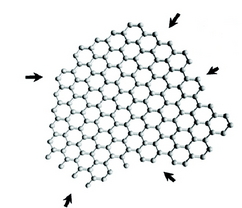Graphene ranks highly as a possible material for future high-speed and flexible electronics. Current fabrication routes, which rely on metal substrates, require post-synthesis transfer of the graphene onto a Si wafer, or in the case of epitaxial growth on SiC, temperatures above 1000 °C are required. Both the handling difficulty and high temperatures are not best suited to present day silicon technology. We report a facile chemical vapor deposition approach in which nanographene and few-layer nanographene are directly formed over magnesium oxide and can be achieved at temperatures as low as 325 °C.

Graphene ranks highly as a possible material for future high-speed and flexible electronics. Current fabrication routes, which rely on metal substrates, require post-synthesis transfer of the graphene onto a Si wafer, or in the case of epitaxial growth on SiC, temperatures above 1000 °C are required. Both the handling difficulty and high temperatures are not best suited to present day silicon technology. We report a facile chemical vapor deposition approach in which nanographene and few-layer nanographene are directly formed over magnesium oxide and can be achieved at temperatures as low as 325 °C.
